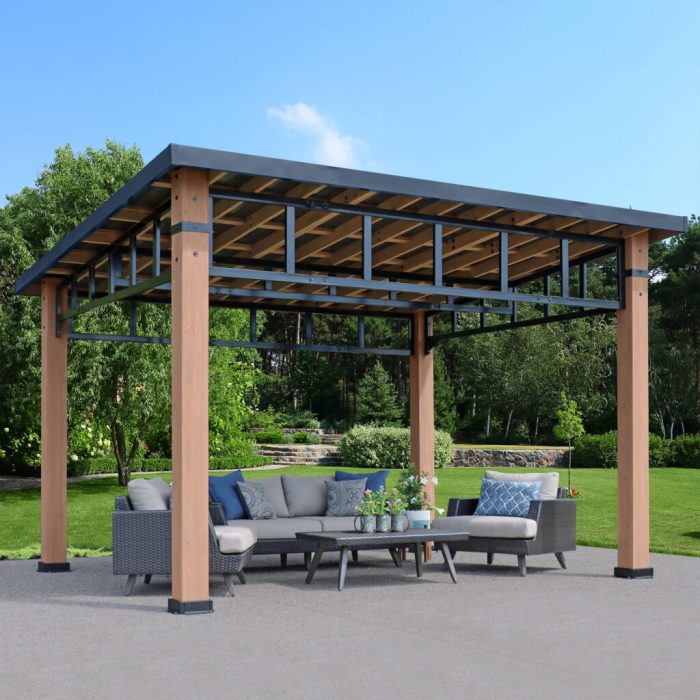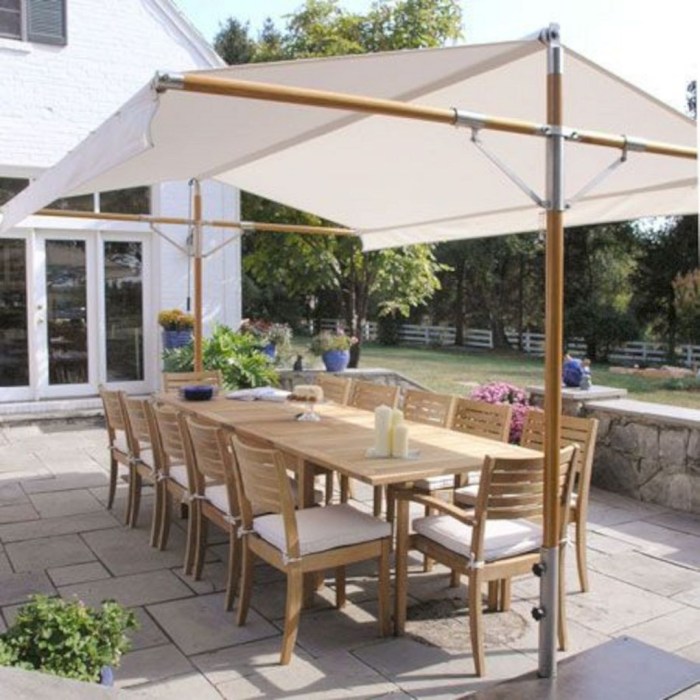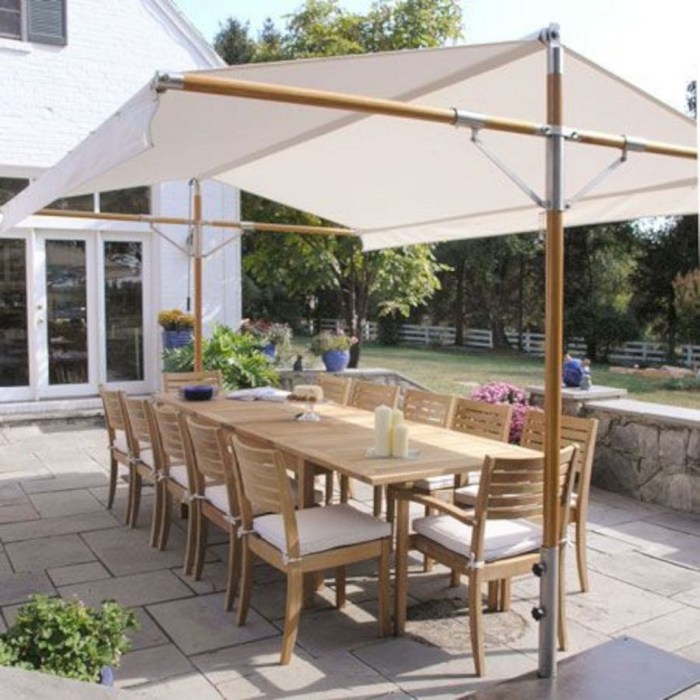Diy outdoor canopy – DIY outdoor canopies offer a unique blend of functionality and style, transforming your outdoor space into a haven of shade and comfort. Whether you envision a cozy retreat for relaxation or a vibrant gathering spot for entertaining, building your own canopy empowers you to personalize your outdoor sanctuary.
This guide will walk you through every step of the process, from planning and design to construction and installation. You’ll discover a range of canopy styles, materials, and techniques to suit your needs and preferences, allowing you to create a truly bespoke outdoor haven.
Planning and Design: Diy Outdoor Canopy

Building a DIY outdoor canopy is an exciting project that can transform your outdoor space. Before you begin, it’s crucial to plan carefully, considering factors such as size, shape, materials, and budget. A well-thought-out design will ensure a sturdy and aesthetically pleasing canopy that meets your needs.
Determining Canopy Size and Shape
The size of your canopy should be determined by the space you have available and the purpose of the canopy. Consider the number of people you want to accommodate, the furniture you plan to place under it, and the amount of shade you desire. The shape of the canopy can also influence its functionality and aesthetics. Common shapes include rectangular, square, octagonal, and circular.
Choosing Canopy Materials
The materials you choose will affect the durability, cost, and aesthetic appeal of your canopy. Common materials for canopy frames include:
- Wood: Offers a natural look and can be easily customized. However, wood requires regular maintenance to prevent rot and decay.
- Metal: Provides strength and durability, but can be more expensive. Metal frames are often made from aluminum, steel, or iron.
- PVC: A lightweight and affordable option that is often used for temporary canopies. PVC is weather-resistant but may not be as durable as wood or metal.
The canopy cover can be made from a variety of materials, including:
- Canvas: Durable and water-resistant, canvas is a classic choice for outdoor canopies. It can be treated with waterproofing agents for added protection.
- Polyester: Offers excellent UV protection and is generally more affordable than canvas. Polyester can be treated with water-repellent coatings.
- Acrylic: A lightweight and weather-resistant material that is often used for retractable awnings. Acrylic can fade over time, but it is easy to clean.
Budgeting for Your Canopy Project
It’s essential to set a realistic budget before you start shopping for materials. Consider the cost of the frame, cover, hardware, and any additional features, such as lighting or a fan. You can save money by using recycled materials or by purchasing materials in bulk.
Design Inspiration, Diy outdoor canopy
When designing your canopy, consider your personal style and the overall aesthetic of your outdoor space. You can find inspiration from existing canopy structures, architectural styles, and even nature itself. For example, you could create a canopy that mimics the shape of a tree canopy or a more modern, geometric design.
Safety Considerations
Safety should always be a top priority when building any structure. Ensure that your canopy is stable and secure, especially if it will be exposed to strong winds or heavy rain. Use high-quality materials and follow building codes to minimize the risk of accidents.
Materials and Tools
Choosing the right materials and tools for your DIY outdoor canopy is essential for a sturdy and aesthetically pleasing structure. You’ll need to consider the size, shape, and style of your canopy, as well as the climate and environment where it will be located.
Materials
The materials you choose will impact the overall cost, durability, and appearance of your canopy.
- Wood:
- Pressure-treated lumber: This is a popular choice for outdoor canopies as it is resistant to rot, decay, and insect damage. Common options include cedar, redwood, and pine.
- Hardwoods: Hardwoods like oak, maple, and cherry are strong and durable but more expensive than pressure-treated lumber.
- Softwoods: Softwoods like pine and fir are less expensive than hardwoods but are not as durable.
- Metal:
- Aluminum: Lightweight, rust-resistant, and easy to work with.
- Steel: Strong and durable, but can be susceptible to rust if not properly treated.
- Iron: Offers a classic look and can be easily customized, but requires maintenance to prevent rust.
- Fabric:
- Canvas: Durable, water-resistant, and available in various colors and patterns.
- Polyester: Lightweight, fade-resistant, and easy to clean.
- Acrylic: Water-resistant, fade-resistant, and available in a wide range of colors.
- Vinyl: Waterproof, durable, and easy to clean.
- Hardware:
- Screws: Choose screws that are appropriate for the materials you are using.
- Brackets: For attaching the canopy frame to the posts.
- Hinges: For attaching the canopy cover to the frame.
- Fasteners: For securing the canopy to the ground.
Tools
You will need a variety of tools to build your DIY outdoor canopy.
- Measuring tape: For accurate measurements.
- Level: To ensure the canopy is level.
- Saw: For cutting wood or metal.
- Drill: For drilling holes for screws and fasteners.
- Screwdriver: For driving screws.
- Hammer: For driving nails and fasteners.
- Safety glasses: To protect your eyes from debris.
- Work gloves: To protect your hands.
Installation and Finishing
With your canopy frame assembled, it’s time to put it in place and give it that final touch of elegance. The installation process is straightforward, and the finishing touches allow you to personalize your canopy.
Securing the Canopy
Securing your canopy is paramount to ensuring its stability and longevity. The method you choose will depend on your canopy’s size, the material used, and the location where it’s being installed.
Here are some common methods:
- Ground Anchors: For canopies installed on the ground, ground anchors are the most common method. These anchors are typically made of metal and are driven into the ground using a mallet or sledgehammer. The anchors are then attached to the canopy frame using sturdy ropes or straps. Ensure that the anchors are positioned strategically, considering the canopy’s weight and potential wind loads. For extra security, you can use concrete to solidify the anchors.
- Deck or Patio Mounting: If your canopy is being installed on a deck or patio, you can secure it to the structure using bolts or screws. Make sure the mounting points are strong enough to support the canopy’s weight and that you use appropriate fasteners.
- Wall Mounting: For canopies installed against a wall, you can secure them using brackets and bolts. Ensure that the wall is strong enough to support the canopy’s weight and that you use appropriate fasteners.
Finishing Touches
After the canopy is securely in place, you can add finishing touches to enhance its aesthetic appeal and protect the wood.
- Painting or Staining: Painting or staining the wood can protect it from the elements and give it a more polished look. Choose a paint or stain that is specifically designed for outdoor use. Consider using a sealant to protect the paint or stain from fading and weathering.
- Decorative Elements: Add decorative elements such as curtains, lights, or plants to enhance the canopy’s aesthetic appeal. Consider using materials that are weather-resistant and complement the canopy’s design.
Safety Considerations

Building and using a DIY outdoor canopy requires careful attention to safety to prevent accidents and ensure the well-being of yourself and others. This section explores essential safety measures, potential hazards, and guidelines to ensure a safe experience.
Wind Loads and Stability
Wind can pose a significant threat to the structural integrity of a canopy, potentially causing it to collapse or become unstable.
- Use sturdy materials: Select strong and durable materials for the frame, such as metal or treated lumber, to withstand wind forces.
- Secure anchoring: Properly anchor the canopy to the ground using heavy-duty stakes, concrete footings, or other secure methods.
- Consider wind resistance: Factor in the local wind conditions and choose a canopy design that can withstand expected wind speeds.
- Reduce sail area: Minimize the canopy’s surface area exposed to wind by using a smaller canopy or adjusting its shape to reduce wind resistance.
- Use a wind gauge: Invest in a wind gauge to monitor wind speeds and take appropriate precautions, such as securing the canopy or taking it down during high winds.
Rainwater Management
Rainwater can accumulate on the canopy, creating potential hazards such as leaks, water damage, and slipping.
- Proper drainage: Ensure the canopy has adequate drainage to prevent water from pooling on the surface.
- Waterproof materials: Choose waterproof or water-resistant materials for the canopy fabric and frame.
- Gutter system: Install a gutter system to direct rainwater away from the canopy and prevent leaks.
- Regular maintenance: Regularly inspect the canopy for any signs of damage or leaks and address them promptly.
Structural Integrity
The canopy’s structural integrity is crucial for its stability and safety.
- Use appropriate fasteners: Employ strong and durable fasteners, such as bolts, screws, or brackets, to securely connect the frame components.
- Reinforce weak points: Identify and reinforce any weak points in the structure, such as joints or corners.
- Regular inspections: Conduct regular inspections to check for any signs of damage, wear, or loose connections.
- Avoid overloading: Do not overload the canopy with excessive weight, such as heavy furniture or equipment.
Building a DIY outdoor canopy is a rewarding endeavor that allows you to express your creativity and enhance your outdoor living experience. With careful planning, attention to detail, and a touch of ingenuity, you can craft a custom canopy that provides shade, shelter, and a touch of elegance to your outdoor space. So, gather your tools, unleash your inner builder, and embark on a project that will transform your backyard into a sanctuary of style and comfort.

